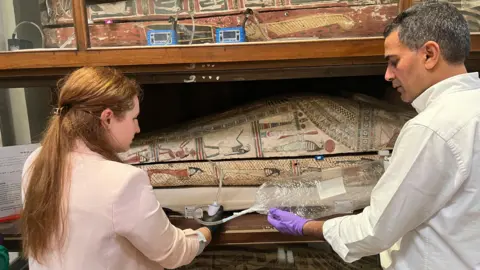

AP
After spending 5,000 years in a sarcophagus, mummies from ancient Egypt still emit surprisingly pleasant scents, according to recent scientific findings.
A study examining nine mummies revealed that although the intensity of their aromas varied, each could be characterized as “woody,” “spicy,” and “sweet.”
The researchers believe that recreating these scents chemically will enable others to experience the fragrance of these ancient remains and help determine when mummies might begin to deteriorate.
Dr. Cecilia Bembibre, one of the study authors, shared with BBC Radio 4’s Today program, “We aim to share the unique experience of smelling these mummified remains, planning to present our findings in the Egyptian Museum in Cairo.”
During the mummification process, ancient Egyptians prioritized incorporating delightful fragrances as part of the ritual to prepare the spirit for the afterlife.
Pharaohs and nobility were anointed with premium oils, waxes, and balms during this sacred process.
Dr. Bembibre remarked, “In popular culture, encounters with mummified remains are often portrayed negatively. We were astonished by their surprisingly pleasant scents.”
The findings from this study, published in the Journal of the American Chemical Society, involved extracting scents from the sarcophagus while preserving the mummy’s integrity.
The team, which included researchers from UCL and the University of Ljubljana in Slovenia, utilized a small tube to gauge the fragrance without extracting physical samples.
Dr. Bembibre explained that heritage scientists are constantly seeking “non-invasive” methods to uncover new insights.

AP
Visitors to museums will gain a fresh perspective on ancient Egypt and the mummification traditions through these captivating scents.
Ally Louks, an English literature lecturer at the University of Cambridge, who authored her PhD thesis on the politics of smell, describes this initiative as a “truly innovative” approach to presenting historical narratives.
“Engaging the sense of smell evokes a powerful emotional and physical reaction,” she shared with BBC.
Dr. Louks emphasized the significance of scents in ancient Egypt’s social, religious, and personal practices.
Matija Strlič, another research participant, mentioned to the Associated Press that the fragrances could offer clues about the social status of the mummy.
“We believe this technique could be of great interest for other museum collections,” he added.
In addition to allowing museum visitors to experience mummies through their scents, this discovery may lead to advancements in mummy preservation techniques.
The research team employed gas chromatography to analyze the different odors present in the sarcophagus, identifying the breakdown of animal fats used in embalming, which could signal the onset of decomposition.
These insights could facilitate “effective interventions” in mummy conservation strategies, as detailed in the research publication.
According to Dr. Bembibre, “This information is invaluable for conservators to ensure the preservation of this collection for future generations.”










